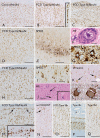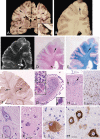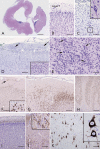Malformations of cortical development
- PMID: 22497611
- PMCID: PMC8092961
- DOI: 10.1111/j.1750-3639.2012.00581.x
Malformations of cortical development
Abstract
Structural abnormalities of the brain are increasingly recognized in patients that suffer from pharmacoresistant focal epilepsies by applying high-resolution imaging techniques. In many of these patients, epilepsy surgery results in control of seizures. Neuropathologically, a broad spectrum of malformations of cortical development (MCD) is observed in respective surgical brain samples. These samples provide a unique basis to further understand underlying pathomechanisms by molecular approaches and develop improved diagnostics and entirely new therapeutic perspectives. Here we provide a comprehensive description of neuropathological findings, available classification systems as well as molecular mechanisms of MCDs. We emphasize the recently published ILEA classification system for focal cortical dysplasias (FCDs), which are now histopathologically distinguished as types I to III. However, this revised classification system represents a major challenge for molecular neuropathologists, as the underlying pathomechanisms in virtually all FCD entities will need to be specified in detail. The fact that only recently, the mammalian target of rapamycin (mTOR)-antagonist Everolimus has been introduced as a treatment of epilepsies in the context of tuberous sclerosis-associated brain lesions is a striking example of a successful translational "bedside to bench and back" approach. Hopefully, the exciting clinico-pathological developments in the field of MCDs will in short term foster further therapeutic breakthroughs for the frequently associated medically refractory epilepsies.
© 2012 The Authors; Brain Pathology © 2012 International Society of Neuropathology.
Figures






Similar articles
-
Malformations of cortical development and epilepsies: neuropathological findings with emphasis on focal cortical dysplasia.Epileptic Disord. 2009 Sep;11(3):181-93. doi: 10.1684/epd.2009.0261. Epub 2009 Sep 8. Epileptic Disord. 2009. PMID: 19736171 Review.
-
Epilepsies associated with focal cortical dysplasias (FCDs).Acta Neuropathol. 2014 Jul;128(1):5-19. doi: 10.1007/s00401-014-1304-0. Epub 2014 Jun 12. Acta Neuropathol. 2014. PMID: 24916270 Review.
-
Neuropathological work-up of focal cortical dysplasias using the new ILAE consensus classification system - practical guideline article invited by the Euro-CNS Research Committee.Clin Neuropathol. 2011 Jul-Aug;30(4):164-77. doi: 10.5414/np300398. Clin Neuropathol. 2011. PMID: 21726501
-
Focal Cortical Dysplasias: clinical implication of neuropathological classification systems.Acta Neuropathol. 2010 Sep;120(3):359-67. doi: 10.1007/s00401-010-0714-x. Epub 2010 Jul 4. Acta Neuropathol. 2010. PMID: 20607544 Review.
-
Malformations of cortical development and epilepsy: A cohort of 150 patients in western China.Seizure. 2015 Nov;32:92-9. doi: 10.1016/j.seizure.2015.09.009. Epub 2015 Sep 25. Seizure. 2015. PMID: 26552571
Cited by
-
Mosaic trisomy of chromosome 1q in human brain tissue associates with unilateral polymicrogyria, very early-onset focal epilepsy, and severe developmental delay.Acta Neuropathol. 2020 Dec;140(6):881-891. doi: 10.1007/s00401-020-02228-5. Epub 2020 Sep 26. Acta Neuropathol. 2020. PMID: 32979071 Free PMC article.
-
The Most Common Lesions Detected by Neuroimaging as Causes of Epilepsy.Medicina (Kaunas). 2021 Mar 22;57(3):294. doi: 10.3390/medicina57030294. Medicina (Kaunas). 2021. PMID: 33809843 Free PMC article. Review.
-
MicroRNA regulation and dysregulation in epilepsy.Front Cell Neurosci. 2013 Oct 4;7:172. doi: 10.3389/fncel.2013.00172. Front Cell Neurosci. 2013. PMID: 24109432 Free PMC article. Review.
-
Transcriptome analyses of the cortex and white matter of focal cortical dysplasia type II: Insights into pathophysiology and tissue characterization.Front Neurol. 2023 Mar 15;14:1023950. doi: 10.3389/fneur.2023.1023950. eCollection 2023. Front Neurol. 2023. PMID: 37006485 Free PMC article.
-
Glial adenosine kinase--a neuropathological marker of the epileptic brain.Neurochem Int. 2013 Dec;63(7):688-95. doi: 10.1016/j.neuint.2013.01.028. Epub 2013 Feb 4. Neurochem Int. 2013. PMID: 23385089 Free PMC article. Review.
References
-
- Adriaensen ME, Schaefer‐Prokop CM, Stijnen T, Duyndam DA, Zonnenberg BA, Prokop M (2009) Prevalence of subependymal giant cell tumors in patients with tuberous sclerosis and a review of the literature. Eur J Neurol 16:691–696. - PubMed
-
- Aghakhani Y, Kinay D, Gotman J, Soualmi L, Andermann F, Olivier A et al (2005) The role of periventricular nodular heterotopia in epileptogenesis. Brain 128:641–651. - PubMed
-
- Aida N (1998) Fukuyama congenital muscular dystrophy: a neuroradiologic review. J Magn Reson Imaging 8:317–326. - PubMed
-
- Al‐Saleem T, Wessner LL, Scheithauer BW, Patterson K, Roach ES, Dreyer SJ et al (1998) Malignant tumors of the kidney, brain, and soft tissues in children and young adults with the tuberous sclerosis complex. Cancer 83:2208–2216. - PubMed
Publication types
MeSH terms
LinkOut - more resources
Full Text Sources
Other Literature Sources
Medical
Miscellaneous

